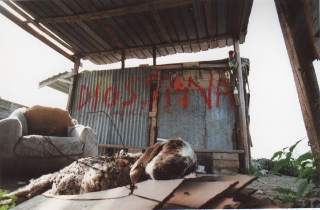 [By Marco Armiero e Anna Fava on “Capitalism Nature Socialism”] In the last few years, Acerra, a town in the Neapolitan hinterland in Italy, has become the epicenter of a waste crisis that has engulfed the entire Campania region since 1994 (see Figure 1). According to the corporate/governmental plan, the construction of a gigantic incinerator in Acerra should have definitely solved the so-called waste emergency, bringing progress to Italy’s underdeveloped South. In this paper, we will address neither the waste crisis in Campania 1 nor the efficacy of the controversial incinerator; 2 nevertheless, we believe that the story we will tell has something to say about the real contamination of Campania and maybe also raise a few doubts about the reasons for placing the incinerator in Acerra.
[By Marco Armiero e Anna Fava on “Capitalism Nature Socialism”] In the last few years, Acerra, a town in the Neapolitan hinterland in Italy, has become the epicenter of a waste crisis that has engulfed the entire Campania region since 1994 (see Figure 1). According to the corporate/governmental plan, the construction of a gigantic incinerator in Acerra should have definitely solved the so-called waste emergency, bringing progress to Italy’s underdeveloped South. In this paper, we will address neither the waste crisis in Campania 1 nor the efficacy of the controversial incinerator; 2 nevertheless, we believe that the story we will tell has something to say about the real contamination of Campania and maybe also raise a few doubts about the reasons for placing the incinerator in Acerra.
Although we have chosen to adopt a storytelling approach, reclaiming the power of toxic biographies (Newman 2012) in order to understand unequal socio-ecological configurations, we frame our narrative within Alaimo’s (2010) transcorporeality theory, Nixon’s (2011) theorization of slow violence (Nixon 2011), and the rich scholarship on environmental justice activism, and more specifically on Pulido’s (1998) subaltern environmentalism. Acerra’s tale of dioxin, sheep, and humans literally embodies the notion of transcoporeality, revealing the porosity of human/nonhuman ecologies. While we focus on the epiphany of this revelation, that is, the illness and death of Vincenzo, a shepherd from Acerra, we also appeal to Nixon’s slow violence, which allows us to place his contaminated body in an ecology of space and time, in which the accumulation of toxins mirrors the histories of exploitation of both humans and places.
In conclusion of our narrative, we argue that the slow violence which killed Vincenzo and his sheep also had transformative power, contributing to uncovering the unjust distribution of environmental burdens and converting victims into activists. The transcorporeal circulation among sheep, humans, the grass, and the factory challenges the anthropocentrism usually inherent to environmental justice. While in this article we do not embrace the sheep’s perspective, we do believe that uncovering the bodily connections between human and nonhuman animals can lead to a quest for a more-than-human emancipatory project.
Setting the Scene For several centuries, Acerra has been a rural village where everything revolved around farming and herding. The soil was extremely fertile due to its volcanic origin and an abundance of aquifers. Three volcanoes (Vesuvius, Campi Flegrei, and Roccamonfina) are embraced within a territory crossed by a network of channels dating back to the 17th century. At the beginning of the 19th century, a monumental geographical dictionary of the Kingdom of Naples described the town of Acerra with the following words:
Everywhere in Acerra the soil is extremely fertile producing corn and legumes … . Wines are light because the soil is filled with water … . There fruit trees grow and produce very well … . There are excellent grazing lands for animals, especially buffaloes. (Giustiniani 1804, 40)
Today, of 2598 hectares available, 2492 are devoted to agriculture, 2176 hectares for crops, and 290 for fruit trees. Together with its surrounding province, Acerra represents 67 percent of the entire agricultural production of the Campania region. 2011 statistical survey showed 625 agricultural firms operating in Acerra (Regione Campania 2013).
Among those firms, the Gerlando 3 and Cannavacciuolo families’ sheep farm was one of the most ancient in the area. The identification code for the Cannavacciuolo’s farm, NA001NA, proves that it was the first one registered in the entire Neapolitan province. On average, the annual profit has been…
To read the article, click here.
Posted on Tandfonline.com on May 24, 2016
